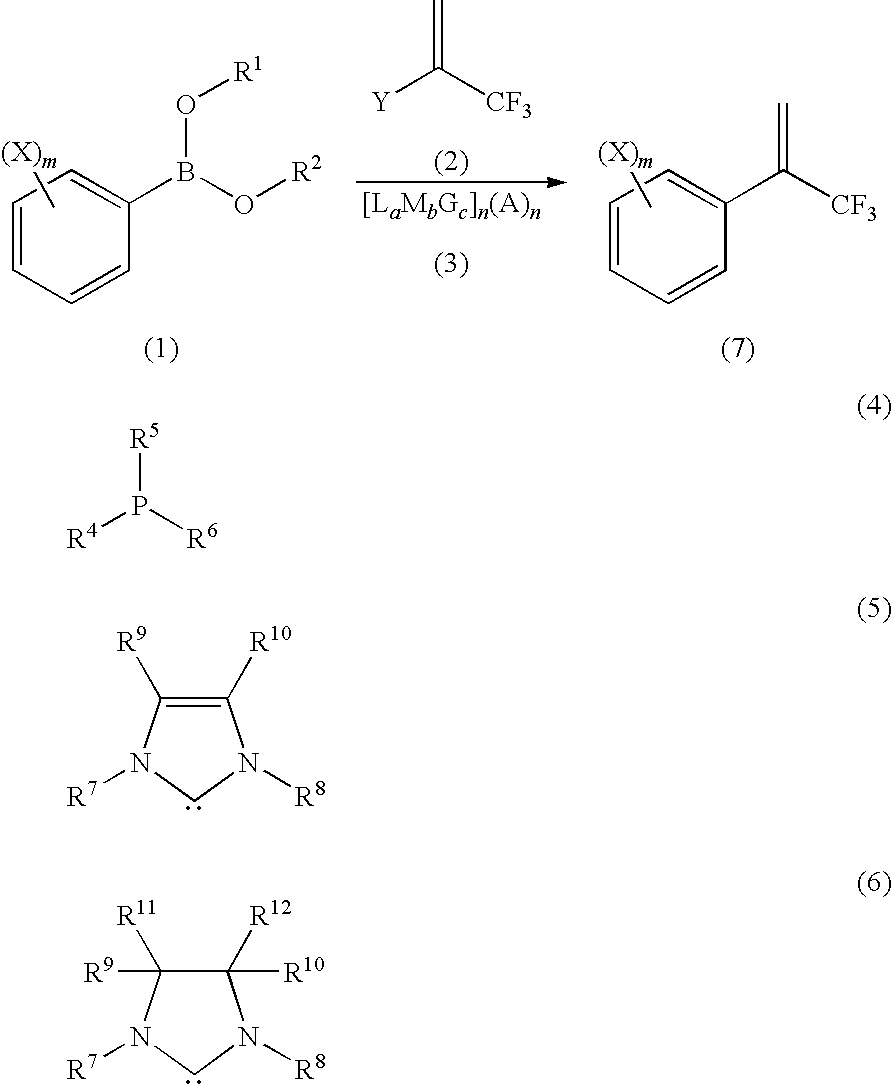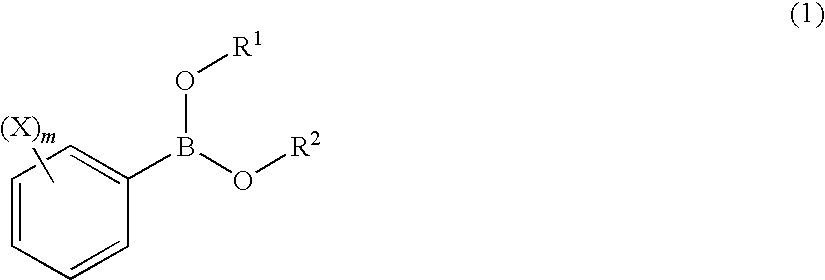Process for Production of 2-(Substituted Phenyl)-3,3,3-Trifluoropropene Compound
a technology of trifluoropropene and substituted phenyl, which is applied in the preparation of halogenated hydrocarbons, organic chemistry, carboxylic acid amides, etc., can solve the problems of process capable of producing industrially the above compound and not necessarily satisfying the circumstances, and achieves high selectivity and high efficiency
- Summary
- Abstract
- Description
- Claims
- Application Information
AI Technical Summary
Benefits of technology
Problems solved by technology
Method used
Image
Examples
example 1
[0073]95 mg (0.5 mmol) of 3,5-dichlorophenylboronic acid and 130 mg (0.75 mmol) of 2-bromo-3,3,3-trifluoropropene were dissolved in 3 mL of tetrahydrofuran and to the resultant solution, 2 mL of water, 138 mg (1.0 mmol) of potassium carbonate and 3.28 mg (0.005 mmol as palladium) of 1,3-bis(2,6-diisopropylphenyl)imidazol-2-ylidene(1,4-naphthoquinone)palladium(0)dimer were added, followed by stirring at 90° C. in an airtight container in a nitrogen atmosphere for 5 hours. After the reaction completion, the product was cooled and was analyzed by the high performance liquid chromatography. The product was identified using an LCMS (Liquid Chromatography Mass Spectrometry) or a GCMS (Gas Chromatography Mass Spectrometry). The main product was 2-(3,5-dichlorophenyl)-3,3,3-trifluoropropene and the area percentage of 2-(3,5-dichlorophenyl)-3,3,3-trifluoropropene was 94% as measured by the high performance liquid chromatography (detected using a UV detector at a wavelength of 254 nm).
examples 8 to 10
[0076]The reaction was performed similarly as in Example 1 and Comparative Example 1 respectively, except that the catalyst, solvent and temperature were changed to those shown in Table 2. The resultants respectively corresponding 2(3,5-dichlorophenyl)-3,3,3-trifluoropropene were identified using an LCMS or a GCMS and the area percentage of 2-(3,5-dichlorophenyl)-3,3,3-trifluoropropene was measured by the high performance liquid chromatography (detected using a UV detector at the wavelength of 254 nm).
example 11
[0077]1,3-bis-(2,6-diisopropylphenyl)imidazolium chloride (IPr.HCl, 0.005 mmol) and palladium acetate (0.005 mmol) were dissolved in 1 mL of tetrahydrofuran and the resultant solution was stirred for 15 minutes to prepare a catalyst solution. In another container, 95 mg (0.5 mmol) of 3,5-dichlorophenylboronic acid and 130 mg (0.75 mmol) of 2-bromo-3,3,3-trifluoropropene were dissolved in 2 mL of tetrahydrofuran and to the resultant solution, 2 mL of water and 138 mg (1.0 mmol) of potassium carbonate, and thereafter the above catalyst solution were added, followed by stirring at 90° C. in an airtight container in a nitrogen atmosphere for 5 hours. After the reaction completion, the product was cooled and was analyzed by the high performance liquid chromatography. The product was identified using an LCMS or a GCMS. The main product was 2-(3,5-dichlorophenyl)-3,3,3-trifluoropropene and the area percentage of 2-(3,5-dichlorophenyl)-3,3,3-trifluoropropene was 73% as measured by the high ...
PUM
| Property | Measurement | Unit |
|---|---|---|
| Digital information | aaaaa | aaaaa |
| Digital information | aaaaa | aaaaa |
Abstract
Description
Claims
Application Information
 Login to View More
Login to View More - R&D
- Intellectual Property
- Life Sciences
- Materials
- Tech Scout
- Unparalleled Data Quality
- Higher Quality Content
- 60% Fewer Hallucinations
Browse by: Latest US Patents, China's latest patents, Technical Efficacy Thesaurus, Application Domain, Technology Topic, Popular Technical Reports.
© 2025 PatSnap. All rights reserved.Legal|Privacy policy|Modern Slavery Act Transparency Statement|Sitemap|About US| Contact US: help@patsnap.com



